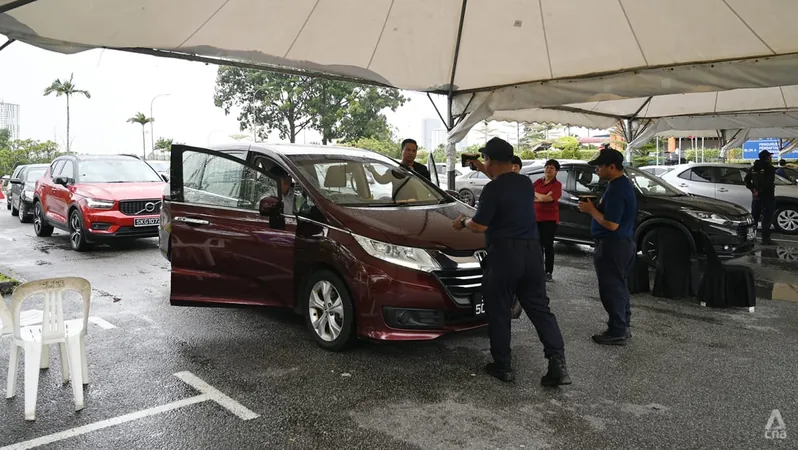
Singaporean Drivers Rush to New VEP Centers in Johor Bahru: Is the Deadline a Game-Changer?
2024-09-27
Introduction
As the looming deadline approaches, Singaporean drivers are overwhelmingly flocking to two new Vehicle Entry Permit (VEP) centers in Johor Bahru, Malaysia. With the requirement to install a radio frequency identification (RFID) tag on their vehicles by October 1, the urgency has turned what could have been a routine process into a frenzied race against time.
Personal Experiences
One Singaporean, Danish Mohd Sami, was all smiles as he completed the installation of his RFID tag at the Road Transport Department (JPJ) complex in Taman Daya on Thursday morning. 'I am really happy to get this done. The process has been mixed—initially slow, but the installation today was very smooth,' said Danish, who started the journey two months earlier with an online application.
Arriving early at the center allowed Danish to enjoy breakfast nearby before diving into the process, which took just 20 minutes. His early arrival was strategic, as many others seemed to have the same idea amid reports of long queues building up at both the Taman Daya and Larkin centers.
Capacity and Penalties
Since the new centers opened on September 23, JPJ announced they could handle up to 1,500 tag installations daily, a significant increase aimed at accommodating the rush. Foreign-registered vehicles entering Malaysia from Singapore have been required to possess VEPs since the announcement by Malaysian Transport Minister Anthony Loke in May. The penalty for failing to comply? A staggering fine of up to RM2,000 (about $484) or potential jail time of up to six months.
On-the-Ground Experiences
On the ground, the situation varied from orderly to chaotic. At Taman Daya, which was designed to process drivers with scheduled appointments only, queues were manageable. In contrast, the Larkin center experienced a far more disorganized setup, leading to long waits that some drivers estimated could take over an hour just to get in.
Drivers expressed relief at the efficiency of the tag installation but were also anxious about looming deadlines. A driver named Peter Fok noted the streamlined booking process but highlighted his hassles with registering a second vehicle, reflecting the complexities many drivers are facing as they scramble to comply with the new regulations.
Enforcement and Outlook
With the October 1 deadline fast approaching, confusion surrounds the enforcement methods that will be put in place. JPJ officials indicated that while warning letters may initially suffice for first-time offenders, clarity on stricter penalties is still awaited from the Ministry of Transport.
Additionally, the VEP tag installation has also branched out to Singapore’s Woodlands, where up to 150 tags can be installed daily, providing another option for Singaporean motorists caught in the rush.
Future Implications
Industry experts have speculated that RFID sensors may soon be set up at toll booths, changing the landscape of how Singapore drivers cross into Malaysia. This move isn’t just about regulatory compliance but also a tactical business decision, with the possibility of increased toll rates for Singaporean vehicles entering Johor Bahru.
Conclusion
As the deadline looms, car rental companies like Wahdah are gearing up for increased demand from drivers unable to secure their VEPs in time. Their plans to offer dedicated shuttle services could provide a route for drivers looking to ease their crossing into Malaysia.
In summary, the urgency surrounding the VEP tags serves not merely as a bureaucratic measure but as a pivotal moment that could reshape travel patterns and business dynamics between Singapore and Malaysia. As registration processes become more urgent, the real question remains: how will the enforcement of these regulations affect the daily lives of drivers crossing the Causeway?




 Brasil (PT)
Brasil (PT)
 Canada (EN)
Canada (EN)
 Chile (ES)
Chile (ES)
 España (ES)
España (ES)
 France (FR)
France (FR)
 Hong Kong (EN)
Hong Kong (EN)
 Italia (IT)
Italia (IT)
 日本 (JA)
日本 (JA)
 Magyarország (HU)
Magyarország (HU)
 Norge (NO)
Norge (NO)
 Polska (PL)
Polska (PL)
 Schweiz (DE)
Schweiz (DE)
 Singapore (EN)
Singapore (EN)
 Sverige (SV)
Sverige (SV)
 Suomi (FI)
Suomi (FI)
 Türkiye (TR)
Türkiye (TR)